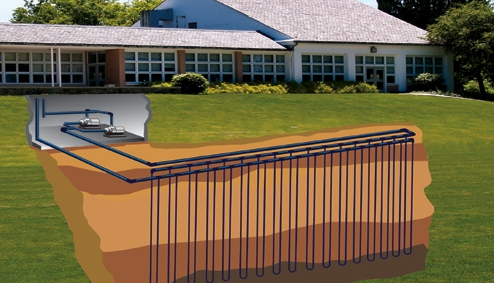Geothermal in Schools
As homeowners, we often neglect the fact that geothermal heating and cooling can be utilized in various types of buildings (with various functions). Geothermal is a viable alternative energy source for any type of building, really (depending upon the size and other factors). Whether it’s a town hall, a corporate office, a shopping mall, or even a school, the benefits of geothermal save face. Today, we’ll focus on geothermal in schools, and provide some additional advantages that pertain directly to a geo installation in an educational facility.
Apart from providing clean air conditioning, heat, and hot water year round, a geothermal heat pump system is an opportunity for schools to take the green initiative, eliminating the oversized boiler rooms and incessant buzzing from their hallways. Unlike traditional “dirty” energy sources, the geothermal heat pump can be easily concealed, while the supporting loop field is completely subterranean. As you can imagine, this concealment prevents the damage that can often occur to traditional heating and cooling equipment. Not to mention, it looks better. While aesthetics aren’t necessarily the main concern of schools across the nation, it certainly can’t hurt to provide children with a safer, cleaner, and better looking environment.

Could this be your school?
Aesthetics aside, geothermal in schools just makes sense. Economically, the heat pump system will pay itself off in a relatively short period of time. Should any problems occur, most ground loop field installations come with a lengthy warranty. From a multitude of examples, we’ve observed that schools employing a geothermal heat pump system have decreased carbon dioxide emissions, while also cutting energy spending substantially.* Also, taking the environmental high road sets a great example for students and their families. Quite frankly, the high road isn’t necessarily the hard road when there’s essentially a guarantee of cutting costs.
The rub, as always, seems to be the fronting of the initial costs of geothermal. In an economy that’s tough on teachers, and perhaps tougher on parents, it’s understandable that not everyone in a given school district is going to be on board with a geothermal installation. That said, it’s important that the school board takes the time to empathize with concerns and reference materials that detail the benefits of geothermal in schools. It’s certainly not for everyone, but it’s also not a technology that should be neglected; its cost benefits alone warrant consideration.
If you’d like to check out a real life example of a geothermal installation in a school, feel free to check out one, two, or all three of the following!
Fond du Lac High School in Fond du Lac, Wisconsin
Pahrump Valley High School in Pahrump, Nevada
Westside High School in Omaha, Nebraska
*Source: FHP-MFG








Many of the schools here in Central Illinois have expressed interest in switching to geothermal heating systems as well.
Geothermal is a great option for residential and commercial buildings.
For decades, geothermal (ground source) heat pumps made a sound investment for institutions of higher education. The recent ARRA stimulus helped fund installations of more American technology in energy efficiency than ever.
Research labs have put the scenario to the test. In Lincoln, NE, researchers compared GHPs with standard HVAC options (air-cooled chiller, VAV air handling system, and gas-fired hot water boiler). By analyzing data from 18 schools with 54 GHP units, 200 tons, 120 vertical loops and computer models, the results were clear. GHPs had the lowest first and lifecycle costs, lower maintenance, reduced energy use (17%) and reduced energy costs (24%). See for yourself! (http://www.ornl.gov/sci/femp/pdfs/ghpsinschools.pdf)
More recently, the Department of Energy (DOE) funded demonstrations of innovative modifications of GHP technology at nine universities, one community college, and three educational systems. Blaine County School District #61 is nearly finished installing 26 wells for six schools and support buildings with the help of a $5M DOE Award. Colorado Northwestern Community College, recently completed, found savings of $54,000 annually in the cost of ownership over a traditional system. Yet, the cost savings are not the only way GHP projects make a difference. Consider the environmental benefits. Preliminary energy models show that CO2 emissions will reduce by 57% at Indiana Institute of Technology, where they are also using CO2 as a refrigerant to transfer the energy!
Overall, institutions can clearly expect big wins for reducing costs, managing risk, and improving the environment with geothermal heat pumps.
My school district is building a new school in 2016. My students have been researching geothermal systems. They would really like to make sure the school district installs a geothermal system in the new school. But the district keeps cutting square footage and is looking at eliminating the geothermal system because of cost. What can we do? The students are concerned about the environmental impact of not including a system. Is there any advice you can give us?